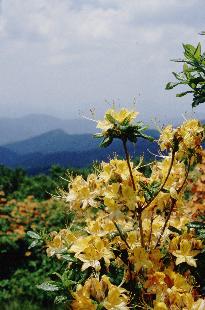Native Azalea Identification Scheme
Using Various Flower and Plant Characteristics
Inspired by Bob Stelloh Internet version by Donald
Hyatt
 The following scheme for identifying native azaleas was developed by Bob Stelloh using the
information provided by Dr. Kathleen A. Kron in her paper published in the Ediniburgh Journal
of Botany, Volume 50, Number 3. In Tables 2 and 3 that appear in Dr. Kron's thesis
on pages 254-256,
she has identified 26 different charactistics of species in the Pentanthera Subsection
of the genus Rhododendron, the deciduous azalea species that have five stamens. which
includes most of the native azaleas found in the Eastern United States. Using
elements from this key, it is possible to clearly differentiate among the various forms.
This application currently uses just 12 of those characteristics, the ones identified by
Bob Stelloh in his scheme for identifying native azaleas which is presented here in
an interactive web application.
The following scheme for identifying native azaleas was developed by Bob Stelloh using the
information provided by Dr. Kathleen A. Kron in her paper published in the Ediniburgh Journal
of Botany, Volume 50, Number 3. In Tables 2 and 3 that appear in Dr. Kron's thesis
on pages 254-256,
she has identified 26 different charactistics of species in the Pentanthera Subsection
of the genus Rhododendron, the deciduous azalea species that have five stamens. which
includes most of the native azaleas found in the Eastern United States. Using
elements from this key, it is possible to clearly differentiate among the various forms.
This application currently uses just 12 of those characteristics, the ones identified by
Bob Stelloh in his scheme for identifying native azaleas which is presented here in
an interactive web application.
When identifying azalea species, the characteristic relating to the Time of Bloom is
probably the most important for distinguishing among the various forms, followed next by
Corolla Color and Blotch characteristics considered together as a group.
Many of the other characteristics are quite subtle, often requiring the use of a magnifying
glass or hand lens to observe such things as tiny hairs on the flowers, stems, or
bud scales. To help you make your decision, you may click on the Help Page Link
button to bring up graphics of representative species having the trait.
If you are unable to make a decision, just choose the option
"Not Sure" rather than guessing.
After you have made as many selections as possible from the pull down menus, then press
the Submit button at the bottom of the page. The application will then give you
probabilities (in percent) of deciduous azalea species matching the characteristics that
you have identified. The higher to 100%, the more likely the match. There is also a link
provided to each of the azalea species with additional information and graphics for
your consideration.
|
|
|
|
|
|
|
|
|
|
|
|
|
Sepal Margin
Are the margins of the sepals fringed with fine hairs along the edge or are
they bristly with strong stiff hairs?
|
Help Page Link
|
|
Pedicel Hairs
Do the pedicels (stems that connect the flowers to the truss) have sticky
glandular hairs or are they eglandular (without glands)?
|
Help Page Link
|
|
Stems
Are the stems of the new growth smooth without any hairs or may have some hairs but
without glands, or are they noticeably hairy with often sticky glands on the hairs?
|
Help Page Link
|
|
Bud Scale Margins
Are the bud scale margins ciliate (or fringed with fine hairs), or are they
glandular with bumby edges that are often brownish and look like "shark's teeth"?
|
Help Page Link
|
|
Bud Scale Surface
Is the surface of the bud scales smooth without hairs, sparsely hairy,
or are the the bud scale definitely hairy?
|
Help Page Link
|
|